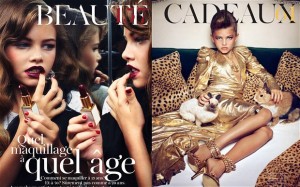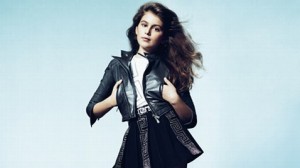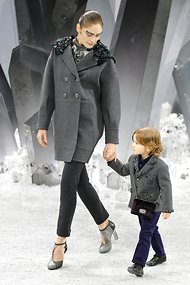Being French is very au courant these days. Thus far Bringing Up Bebe is the parenting book of the year. Paris Fashion Week just ended. And, now, a French report offers several suggestions on how to fight against the hyper-sexualization of young girls. While those last two sentences may seem contradictory, given that France is the fashion capital of the world, perhaps we should listen.
French Senator Chantal Jouanno (former Sport Minister, karate champion, and [I couldn't resist this oh-so-French tidbit] rumored recent mistress of President Sarkozy) wrote a parliamentary report on the precocious sexualization of girls in France. Apparently, as in the US, French tweens are seeking out padded bras, high heels, and make-up. The report targets both the pornography and beauty industries and offers some concrete suggestions for change. I'll only talk about two aspects of the beauty-industrial complex here-- beauty pageants and modelling-- but the porn industry is indicted in the report, a point not getting much coverage in the American press coverage of the story (I mainly learned about it from this UK article).
Jouanno wants to ban child beauty pageants, or "Mini-Miss," for girls under the ages of either 16 or 18. While I appreciate the impulse, which is similar to what was proposed in Australia last year, I don't think it is realistic for two reasons, as I mention in articles in the French press (like this one in French magazine VSD). The first, which I first mentioned while writing about the aborted Australian ban, is that there is nothing inherently illegal about child beauty pageants. As with any childhood activity there is the potential for various forms of abuse (physical, sexual, financial), but the activities themselves aren't abusive. Moreover it is very difficult for democratic governments to tell parents what they can or cannot do with their children. For example, if child beauty pageants are outlawed will gymnastics, dance, and figure skating follow suit? Second, it would be easier to forbid child beauty pageants if they did not exist already. But-- as I am told by French journalists I have spoken with about the report-- child beauty pageants are fairly popular in the north of France. Once an activity is entrenched it is hard to completely eradicate it even in the face of tremendous pressure; in the US even after the murder of JonBenét Ramsey, which led to unprecedented amounts of media attention, the popularity of child pageants somewhat perversely increased.
That said, I hope Jouanno can promote legal restrictions and regulations when it comes to child beauty pageants. These events should be treated like any legitimate business, with organizers following the law carefully (along with rules that anyone with any legal issues related to child endangerment not be allowed around the events). Further, all safety concerns for children related to physical activity and work restrictions (similar to child actors) should be enforced. Finally, any health concerns related to make-up application (like who can charge for services and their level of cleanliness), hair, spray tanning, etc. should be addressed. I hope this will eventually happen in the US as well.
Age restrictions have also been proposed for models. In fact, a child model was the impetus for the French report. In December 2010 10-year-old Thylane Loubry Blondeau appeared in a spread in French Vogue. The images were met with little reaction in France at the time. But about 8 months later they caused a stir in the United States. This then prompted French condemnation. The back-and-forth criticisms abound, with little irony.
 It seems that everyone can agree that ten is a bit young for these types of modelling gigs. But within a few years, by 14, many girls are deemed catwalk ready. While many designers at this year's New York Fashion Week tried to hire only models over 16, this proved more difficult than you might imagine. Again, while it may not be inherently illegal to use such young models, the age appropriateness of the content of their modelling should be considered-- along with child labor laws that should apply to all child performers.
It seems that everyone can agree that ten is a bit young for these types of modelling gigs. But within a few years, by 14, many girls are deemed catwalk ready. While many designers at this year's New York Fashion Week tried to hire only models over 16, this proved more difficult than you might imagine. Again, while it may not be inherently illegal to use such young models, the age appropriateness of the content of their modelling should be considered-- along with child labor laws that should apply to all child performers.
Last month another 1o-year-old model, Kaia Gerber, caused a stir stateside. Gerber, the daughter of two models (mom is Supermodel Cindy Crawford), appeared in a Versace ad.
 While Crawford was initially enthusiastic about Gerber's images, after quite a bit of negative press, she later backpedaled and said her daughter would be taking a break from modelling for several years.
While Crawford was initially enthusiastic about Gerber's images, after quite a bit of negative press, she later backpedaled and said her daughter would be taking a break from modelling for several years.
Unlike Crawford model father Brad Kroenig seems to have received little to no backlash for letting his child, 3-year-old Hudson, walk in Paris Fashion Week for Chanel.
 Now, of course, Hudson is a boy. So his modelling exploits are celebrated on the pages of The New York Times. Will we soon see a French report warning of the dangers of young male models as well? Somehow I don' t think so...
Now, of course, Hudson is a boy. So his modelling exploits are celebrated on the pages of The New York Times. Will we soon see a French report warning of the dangers of young male models as well? Somehow I don' t think so...




